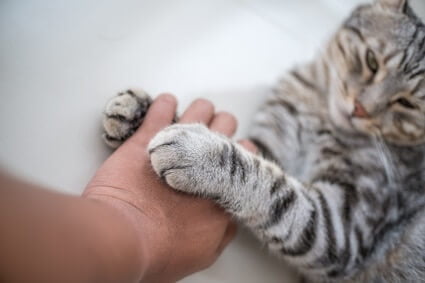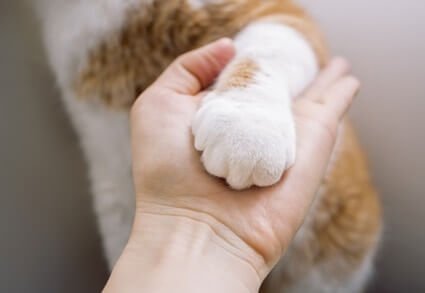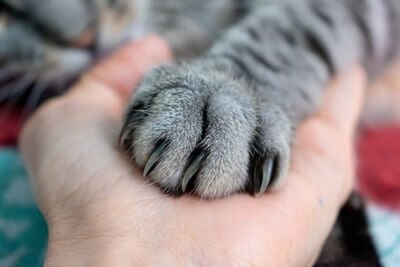Most cats will tug their paw away from your hand if you try to touch them. Others will respond with aggression, hissing, or even batting at your hand. This is especially true if you touch the pad or the toe beans, which are extra sensitive. It may seem trivial, but cats have good reasons for protecting their paws.
Cats dislike having their paws touched because they’re full of nerve endings, making them highly sensitive. Older cats may have joint issues, and rescued cats may have bad experiences with the contact. If the cat’s paw is injured, touching the pad may even be painful. This is also true if you handle the cat too roughly or apply unnecessary pressure on its paw. Of course, every cat has its own personality, so it may just dislike the feeling itself unless it’s trained from a young age.
You can let the cat have its own personal space. However, if the cat is injured or walked through something dangerous to lick off, you may have to intervene. To prepare for those events, you can train your cat to be more accepting of the touch. By being patient, using treats, and choosing the right training times, you can acclimate the cat.
Do Cats Let You Touch Their Paws?
Most cats will not allow you to touch their paws. Attempts to touch the paws will usually be met with the cat:
- Hiding its paws, often by tucking them under its chest
- Getting up and moving away from you
- Hissing or batting at you, if the cat is more aggressive
While this isn’t true for every cat (and some will allow the contact), most will react adversely. Even well-socialized cats may dislike the touch and try to pull away if they can.
An exception is only found in cats that are hand-raised from a young age. If they are socialized to allow handling on all parts of their body, they may have no opinion about the contact. It’s unlikely that any cat will actively enjoy humans (or any creature) touching its paws. At best, it will tolerate the contact.
Do Cats Like Their Paw Pads Touched?
Some cats are friendlier than others and may allow you to rub the top of their paw. However, if you pick up the paw, rub it between your fingers, or dare touch the paw pad itself, the cat may rebel.
That’s because felines are defensive of their paw pads. These are the most sensitive areas and the most prone to injury. Being protective of this spot is a good way for cats to avoid pain, discomfort, or injury. That can be true even for well-socialized cats.
Why Do Cats Not Let You Touch Their Paws?
A cat’s paw works as one of its main defense mechanisms, alongside its teeth. By refusing to let an owner, another animal, or even another cat touch it, your cat is protecting itself. Here are the main reasons for this defensive behavior:
Sensitive Paws
Cats have a wide variety of nerve endings on their paws and for good reason. The pads are one of their senses, allowing cats to:
- Detect vibrations
- Feel hot and cold temperatures
- Tell the difference between textures
- Register pain
- Feel differences in movement
In fact, a study in The Journal of Physiology determined that cats can distinguish temperatures by up to 1-degree Celsius. All these traits allow a cat to navigate its surroundings better. It can:
- Tell when predators or prey are near.
- Sense changes in the weather.
- Feel temperature differences in the ground it walks on or in the objects it touches.
- Better gauge its balance and pace.
Paw pads are much like your own fingertips, only more sensitive. Cats can learn everything you can through touch and even pick up more complex information.
As such, if your cat refuses to have its paws touched, it may be because it feels uncomfortable. Having someone randomly poke at your fingers is strange. That’s even truer when you can register extra feeling like a cat.
Injury
If your cat usually allows you to touch its paws, but it’s suddenly defensive about it, it may be in pain. Even a little scratch, bruise, or bump on its paw can be very upsetting to a cat. All those extra nerves will amplify the sensation. If you begin to touch or rub the area, this pain may get worse.
It can be hard to see whether an injury is the reason for your cat’s sensitive paws. Your cat may refuse to show you the paws or seclude itself until the injury has mostly healed.
Limping and meowing too much can be a sign that your cat has an injury on its paw. For wounds you can’t get to yourself, consider reaching out to your veterinarian.

Past Trauma
If your cat was previously hurt, and the pain was connected to its paw, it will be more resistant to people touching this area. This is the cat’s way of ensuring that whatever happened to it before will not happen again.
This is especially true for feral or rescued cats. Adopted cats may have been raised in an abusive environment, while feral cats may have been exposed to dangerous situations.
Rough Handling
Cats don’t like to be handled roughly. People who are unfamiliar with cats often handle them with too much force. Grabbing a cat’s paw unexpectedly or applying excessive pressure when you inspect the pad may cause the feline to rebel.
Unlike dogs, your cat will not enjoy the roughhousing or overly-familiar contact. Instead, the cat may retreat away from you, hiss, or even bat with its claws.
They Just Don’t Like It
Cats have their own unique personalities and preferences. Your feline may dislike having its paws touched and refuse to get over this habit.
Rearing the cat from a young age or continuously socializing it will help it become less defensive. However, the cat may always tug its paw away or rebel whenever you try to touch the pad.
Try not to take it personally. The cat just has an opinion about its personal space.
Cat Is Old
Older cats may have osteoarthritis, which often comes with joint pain. If your senior cat has this condition, it will hate having its paws touched.
Other than being a sensitive area, the paws have many joints. Each of these may become inflamed and stiff with age, which makes walking difficult. Any discomfort or pain may become even more apparent if you touch the paws or try to massage the pads. In a study of 28 cats by the Journal of Small Animal Practice, 45% of cats had their elbow affected by osteoarthritis.
Of course, not all felines will get this as they age. You can also catch the symptoms rather early and apply treatment to prevent a full-scale problem. Signs of feline osteoarthritis include:
- Weight loss
- Less mobility
- Poor grooming
- A general change in behavior
What Does It Mean When Cats Let You Touch Their Paws?
While most cats dislike having their paws touched, others will allow it. The reasons for this can be varied, changing from cat to cat. Others remain a complete mystery.
However, if your pet is one of the rare few to allow this type of handling, you can make an educated guess. It may be because the cat is:
Well-Socialized
Cats that are heavily socialized as kittens are more likely to embrace human contact. They’ll be used to handling, be it on their tail, paws, or around their face.
These cats are also more open to training and tolerant of confusing (and sometimes even painful) human interactions. For example, an extremely tame cat may let you investigate its injured paw, even if it’s uncomfortable. It may also accept having its pads massaged if that means getting a treat.
Trusting
If your cat allows you to touch its paws, chances are, it trusts you. Specifically, this indicates that your cat knows you mean well. You’ve proven that you won’t hurt it, at least not intentionally. Even if the cat knows this to be risky (and mildly uncomfortable) behavior, it understands that you probably know best.
Content
When your cat allows you to touch its paws without hesitance, you can rest assured: it is relaxed, happy, and content. Cats are alert animals, and they’re always on the lookout for danger. If the feline is willing to hand over its main method of running, fighting, or warding off danger, then it feels entirely safe.
Should I Touch My Cat’s Paws?
In general, there’s no need to handle your cat’s paws. The feline is capable of grooming itself, maintaining its claws, and healing from minor injuries. If your cat is unwilling to share its paw pads with you, then don’t worry. It’s not necessary.
With that said, there are rare instances where it is needed. Here are good reasons to acclimate your cat to having its paws touched. It may come in handy later!
Cleaning Paw Pads
Some cats will have dirtier paws than others. For example, your cat may play outside and get into dirt or trash. If your cat was reared from a young age, it might also be less adept at cleaning itself and need a little help. Even the tidiest cat may traipse through wet paint or oil and need a helping hand. Licking off that mess by itself could be dangerous.
Trimming Nails
Cats can maintain their nails independently, but that can be troublesome for your furniture. By trimming the cat’s nails, it’s less likely to mark your leather sofa or by scratch up your bedding. It also lessens the number of pocket-marks it leaves in different materials by accident.
Checking For (And Treating) An Injury
Although cats are defensive of their paws, accidents happen. Fights with other cats, walking on sharp objects, or landing badly could leave your feline with an injury.
If you’re used to dealing with cats, you know how adept they are at hiding pain. To spot a problem, it’s worth peeking at your cat’s paws now and then. That’s especially true if it’s acting strange. Any treatment you apply will also require the cat to hold still and offer up its paws without a fight.
How To Get A Cat To Let You Touch Its Paws
Whether it’s for fun, safety, or cleanliness, there are many important reasons to touch your cat’s paws. Luckily, you can train your cat to accept this handling.
Train When Sleepy
Cats that are relaxed will be more open to touches and petting. After all, sleepy cats are cuddly cats. They’re also less likely to meet your petting with aggression. Be sure to place your training sessions after the cat has eaten or played or while it’s lounging in the sun.
Start With Other Areas
When training the cat to accept handling, never start with the paws. Instead, pet areas that your cat already tolerates, like its ears, under its chin, or behind its head. As you continue, gently pet down its legs and massage the back of its paws.

Pet Gradually
As the petting continues, place a finger or two on the back of your cat’s paws. Keep your touch light but firm, and don’t move your hand too much.
If your cat doesn’t seem to like it, remove your hand right away, and proceed with more petting. Repeat these gentle touches for a while until your cat allows the contact for more than a few moments.
Hold The Paw
When your cat is comfortable, you can gently wrap your hand around your cat’s paw. Remember not to squish the paw in your hand. At this stage, your cat will normally remove its paw from your grasp. Don’t force it to stay. Instead, repeat the process if your cat allows.
Remember to be gentler if your cat seems irritated. Eventually, your cat will allow you to turn its paw over and touch the pads.
Take Your Time
When training your cat to do anything, it’s always important to take your time. Go as slow as possible, and don’t rush things. Cats are easily spooked, and your impatience will only make things take longer.
Instead, be sure that your cat is completely used to the first step before going to the next. Go slow, and always make sure that your cat is comfy.
Use Treats
Treats are an essential part of cat training. They allow cats to associate uncomfortable or confusing moments with positive feedback and rewards. Whenever you trim, inspect, or clean your cat’s paw, give your feline a treat.
Why Do Cats Get Mad When You Touch Their Paws?
All in all, cats may get overwhelmed if you touch their paws. It triggers a defensive reaction, as cats rely on their paws as a way to protect themselves. Your cat’s paw pad is also very sensitive, so having it touched may be the equivalent of getting a rough, awkward massage on your face.
With that said, by applying enough patience and care, you can train your cat to allow handling on its paws. Over time, the cat should learn to tolerate the feeling or even look forward to the treats it brings.


HI Richard. Really enjoy your articles. Very informative.
I am fostering the oldest cat in our shelter and she is 17 years old. I adore her and she’s learned that she is safe here. She has the run of the house and is able to lounge outside for some fresh air on the patio. I feed her on demand. She’s old enough to deserve to be fed whenever she’s hungry.
Anyways, Thanks for your writing.